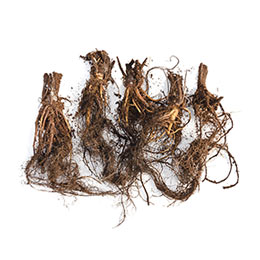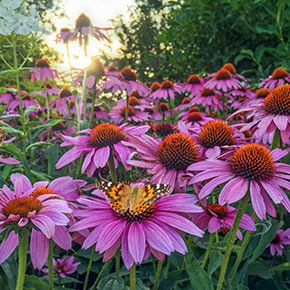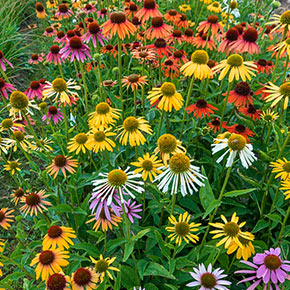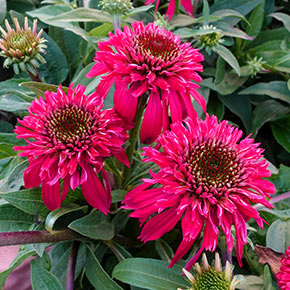-
Spring Planting
Order now for best selections.
-
Fall Planting
Available for preorder for fall 2025 delivery.
-
Bulk Flower Bulbs
Big savings on bulk orders!
- New
-
Gardening Resources
Flower Bulbs & Perennials at Wholesale Prices

How to Plant, Grow, and Care For Coneflowers (Echinacea)
| Botanical Name | Echinacea |
| Plant Type | Herbaceous perennial |
| Sun Exposure | Full sun to partial shade |
| Soil Type | Well-drained acidic, clay, loamy or sandy soils |
| Soil pH | Neutral |
| Bloom Time | Summer to early fall |
| Flower Color | Pink, purple, orange, yellow, white, green and magenta |
| Hardiness Zones | 3, 4, 5, 6, 7, 8, 9 |
| Special Features | Attract butterflies, hummingbirds and songbirds. Excellent cut flower. |
Coneflowers, or Echinacea plants, are some of the most popular perennials in American gardens. Native to much of the eastern and central parts of the United States, these easy-to-grow, low-maintenance perennials are both deer and drought resistant. The cheery, daisylike flowers brighten gardens throughout the summer—and attract butterflies, hummingbirds and songbirds. They're long-lasting cut flowers, too. Symbolizing strength and healing, coneflowers are an excellent perennial for sun-filled borders and look stunning when grown in masses. Below is a guide for how to grow coneflowers.

How to Plant Coneflowers
Dig a hole that is twice the size of the root ball. Place the plant in the hole and fill in with soil, making sure the plant's root ball is level with the top of the soil. Plants should be spaced 18-24" apart. Water thoroughly after planting. The coneflowers may also benefit from Van Bourgondien 100% Natural Perennial Food.
When to Plant Coneflowers
Echinacea plants can be planted in the spring or fall. While they can be started from seed, many gardeners buy plants from nurseries or mail-order catalogs. If planting in the spring, wait until the danger of spring frost has passed. If planting in the fall, plant at least six weeks before the first fall frost date. This gives the plants time to establish their roots. Many coneflower transplants will bloom within a year after planting.
Where to Plant Coneflowers
Coneflowers can be grown in zones 3-9, which covers much of the United States. You can find your grow zone using our zone finder. They grow best in full sun (six or more hours of direct sunlight daily), but can also handle partial shade, especially in warmer climates. While they grow best in well-drained, sandy or loamy soils, they can handle many soil types. If you have clay soil, you can improve its drainage by mixing compost into it. Coneflowers look best when planted in groups.
How to Grow Echinacea Plants
While coneflowers are drought tolerant, provide them with adequate water, or the equivalent of 1 inch of rainfall weekly, until the plants are established. To conserve moisture and suppress weeds, a light mulch can be spread around the plants. In colder climates, young coneflower plants also benefit from mulch over winter.
Growing Coneflowers in Pots
Coneflowers can also be grown in containers. Here's how to grow coneflowers in pots: when selecting a container for coneflowers, the larger the container, the better. A minimum size is two gallons, and it must have drainage holes. After planting coneflowers, place the container in full sun. Coneflowers growing in containers benefit from a slow-release, all-natural fertilizer. Water the plants regularly.
Coneflower Care
Coneflower care is fairly simple and easy. While pruning, or deadheading, the spent flowerheads keeps the plants looking tidy, it is not necessary. The plant will keep blooming. Some gardeners prefer to leave the flowerheads on the plants, as it provides a food source for visiting birds. Depending on the soil conditions, the coneflowers may benefit from an all-natural, slow-release fertilizer. Avoid over-fertilizing, as this can cause the plants to develop more foliage than flowers. Every four years, the plants may need to be divided.
Echinacea FAQs
Are There Common Pests or Diseases Associated With Coneflower Plants?
While coneflowers are generally trouble-free, they are susceptible to aster yellows disease, which is spread by leafhoppers. Other common coneflower pests and diseases are powdery mildew and eriophyid mites.How Long Does it Take Coneflowers to Grow From Seed?
Coneflower seeds usually take 10-21 days to germinate. If starting coneflower seeds indoors, here's how you determine when to plant coneflower seeds: find out the average last spring frost date in your area and sow seeds about 8-10 weeks before the last spring frost date.Why is My Coneflower Turning Black?
Two diseases that may cause your coneflowers to turn black are alternaria leaf spot and bacterial leaf spot.What Flowers Go Well With Coneflowers?
Coneflowers look good planted with many other sun-loving perennials, including Black Eyed Susan, Gaillardia, Monarda, Sedum, Agastache and Lavender.Types of Coneflowers

Purple: One of the most popular coneflowers available, Echinacea purpurea, grows 2-5 ft. tall and is the type often seen growing in open woodlands and prairies. It's stunning when planted in large groups in perennial beds, too.

Single: The most common form of coneflowers, single flowers are reminiscent of daisies and have large, cone-shaped centers. They're available in an array of colors including purple, pink, orange, yellow, white and green.

Double: A unique take on the traditional coneflower, double coneflowers feature distinctive pompom-style blooms in many different hues. They offer the same low maintenance and ease of care as single coneflowers.
| Shop All Flower Bulbs | |
| See More Tips |
Have another question? Return to the Customer Service Help page or send an e-mail directly to Customer Service
Copyright © 2025 Gardens Alive!, Inc. d/b/a Dutchbulbs.com. All Rights Reserved. Dutchbulbs.com trademarks are registered trademarks of Gardens Alive!, Inc.
This site is protected by reCAPTCHA and Google Privacy Policy and Terms apply.
This site is protected by reCAPTCHA and Google Privacy Policy and Terms apply.

Item added to cart





